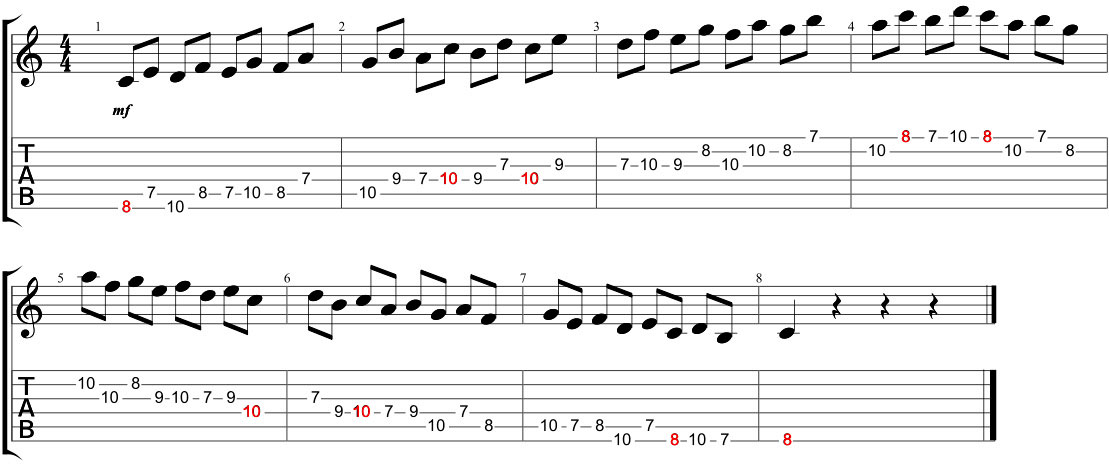November 11, 2019 by Klaus Crow
Intervals are used in all styles of guitar music from pop, blues, country to jazz and classical music.
Learning to play and understand intervals are a great value to your guitar playing. It will help you to understand chords, scales and add beautiful melodic and harmonic ideas to your improvisation.
Today I’ll start with the interval of a third. It’s probably the most often used interval in pop music, but also widely used in all other styles.
In music theory, an interval is the distance in pitch between any two notes. When you play these two notes simultaneously they are called harmonic intervals. When you play the notes separately one after the other they are called melodic intervals.
Here are two ways to determine intervals:
1 – Finding intervals by counting the number of semitones between the two notes.
2 – Finding intervals within a scale. (diatonic intervals)
EXAMPLE 1:
Here are all intervals from C within one octave:
Note: 1/2 step = 1 fret, 1 step = 2 frets.
0 steps = Unison (from C to C) 1/2 step = Minor second (from C to C#)
1 step = Major second (from C to D) 1+1/2 steps = Minor third (from C to D#)
2 steps = Major third (C to E) 2+1/2 steps = Perfect fourth (C to F)
3 steps = Augmented fourth (C to F#) 3+1/2 steps = Perfect fifth (C to G)
4 steps = Minor sixth (C to G#) 4+1/2 steps = Major sixth (C to A)
5 steps = Minor seventh (C to A#) 5+1/2 steps = Major seventh (C to B)
6 steps = Octave (C to C)
EXAMPLE 2:
C major scale: C D E F G A B C
Interval of a 2nd: From C to D, D to E, E to F, F to G, G to A, A to B and B to C
Interval of a 3rd: From C to E, D to F, E to G, F to A, G to B, A to C and B to D
Interval of a 4th: From C to F, D to G, E to A, F to B, G to C, A to D and B to E
Interval of a 5th: From C to G, D to A, E to B, F to C, G to D, A to E and B to F
Interval of a 6th: From C to A, D to B, E to C, F to D, G to E, A to F and B to G
Interval of a 7th: From C to B, D to C, E to D, F to E, G to F, A to G and B to A
In the examples below we first see the C major scale (2 octaves): C D E F G A B C D E F G A B C.
Then we start playing the 3rd intervals within the C major scale and next we’ll be moving them up the neck. The red notes indicate the root notes. All the intervals below are played in the key of C, that means every root notes is a C note.
If you want to play the intervals in a different key like the key of D for example, just move up all the notes a whole step. Your red root note now becomes a D note. If you want to play in the key of E move up 2 whole steps. Play in the key of A? Move all the notes down a 1+1/2 step.
Take your time to learn and memorize the intervals. See if you can make some nice melody.
Enjoy the experience!
C MAJOR SCALE
DIATONIC 3RDS IN THE KEY OF C
3RDS ON THE HIGH E & B STRINGS (MELODIC)
3RDS ON THE HIGH E & B STRINGS (HARMONIC)
3RDS ON THE B & G STRINGS (MELODIC)
3RDS ON THE B & G STRINGS (HARMONIC)
3RDS ON THE G & D STRINGS
3RDS ON THE G & D STRINGS (HARMONIC)
3RDS ON THE D & A STRINGS (MELODIC)
3RDS ON THE D & A STRINGS (HARMONIC)
3RDS ON THE A & LOW E STRINGS (MELODIC)
3RDS ON THE A & LOW E STRINGS (HARMONIC)
Join the Guitarhabits Facebook page to keep up with the latest posts, guitar lesson videos, tips, tricks and other news about Guitarhabits.














Hi Klaus,
I love this website and this is a great post once again!
Just a slight typo I think in the “3rds on the B and G string” at the end. I think it should be 14th and 13th frets and then 16th and 15th instead of 13th and 12th to 14th and 13th, like this:
3RDS ON THE B & G STRINGS (MELODIC)
e————————————————————————-
B—-1—–3—–5—–6—–8——10——12——13——-15——17—
G–2—-4—–5—–7—–9—–10——12——14——-16——17——-D————————————————————————
A————————————————————————-
E————————————————————————-
Thanks,
Chris
Sir amazing stuuff I never seen before thank u
Hi Krishna,
Thanks, have fun with it!
Best regards,
Klaus Crow
hi klaus
do your create your material
or copy it from elsewhere
as
i find your material
much better than other material
on the same subject matter
if you create it
then you have a much better insight
on how to explain things
than most others
great job
thanks
buddy fong
Hi Buddy,
I create my own material.
Thanks, I appreciate it.
Best,
Klaus